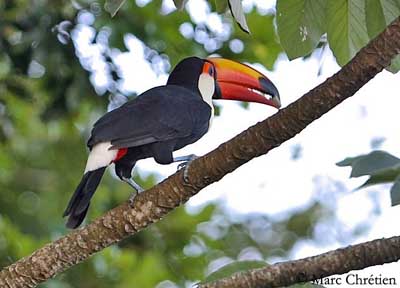
Toco Toucan
Ramphastos toco
Piciforme Order – Ramphastidae Family
BIOMETRICS:
Length: 55-60 cm
Weight: 500-860 g
DESCRIPTION:
Toco Toucan is the largest of the members of family Ramphastidae.
Both sexes are similar.
Adult of nominate race is mostly black on the upperparts, except the white uppertail coverts.
On the black underparts, the bird shows conspicuous white bib, often tinged yellow on the foreneck, and with fine red band behind the white bib. Undertail coverts and vent are red.
Fr: Toucan toco
All : Riesentukan
Esp : Tucán Toco
Ital: Tucano Toco
Nd: Reuzentoekan
Russe: Перцеяд токо
Port: Tucanuçu
Photographers:
Marc Chrétien
MURINUS
Philippe Wolfer
OISEAUX D’ARGENTINE
Text by Nicole Bouglouan
Sources :
HANDBOOK OF THE BIRDS OF THE WORLD Vol. 7 by Josep del Hoyo-Andrew Elliott-Jordi Sargatal – Lynx Edicions – ISBN: 8487334377
Wikipedia (Wikipedia, The Free Encyclopedia)
Welcome to WhoZoo (Jill Foley)

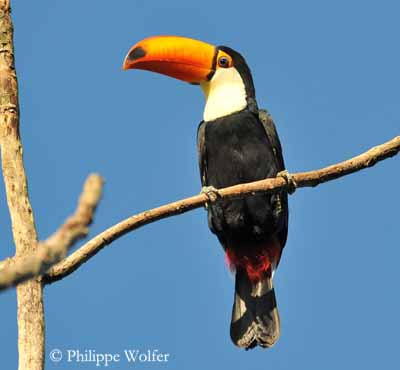
On the head, forehead, crown and nape are black. Facial skin is orange.
The large bill is brightly coloured red, orange and yellow, redder along the ridge of culmen. The upper mandible shows large black spot on tip, and black basal band.
The lower mandible is red-orange with black base too.
The bill is down curved, with slightly serrate mandibles. The fine tongue of 14-15 cm long is laminated along the sides and brush-like towards the tip. Eyes are dark brown, surrounded by violet eye-ring. Legs and feet are grey.
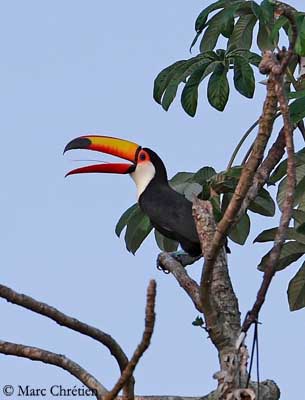
Immature is duller, rather sooty-black with paler colours and whitish eye-ring. The shorter bill has irregular brownish markings and lacks the black spot on tip.
The other race, R.t. albogularis, has shorter bill, less yellow on the white bib and very thin red breast band. But there are numerous variations in both races.
VOICE: SOUNDS BY XENO-CANTO
Toco Toucan utters deep, coarse, grunting “groomkk” notes in series. It also gives rattling calls and uses its fine tongue inside the closed bill to produce clacking sounds and with the bill too.
It sings by stretching the head out and up, and swinging from side to side. During displays and fights, the wings produce much noise.
HABITAT:
Unlike the other toucans, the Toco Toucan is a non-forest species. It prefers semi-open habitats, coastal forest edges, forest patches, savannahs with palm groves, plantations, wooded islands, streamsides, scrubs and orchards.
RANGE:
Toco Toucan occurs in large parts of centre and eastern South America where this species is resident, only performing local movements according to the food sources.
We find it Brazil, Guiana’s, Paraguay, Bolivia and northern Argentina.
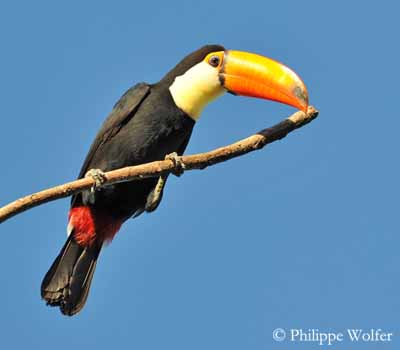
BEHAVIOUR:
Toco Toucan feeds primarily on fruits, using the long bill to reach fruits on small branches. It also takes insects, nestling and eggs of other species, and sometimes lizards.
These birds are usually seen foraging in small groups of 5-6 birds. They often move in single file, performing deep wing beats and glides from site to site. They feed in the canopy but also on the ground where they move by hopping.
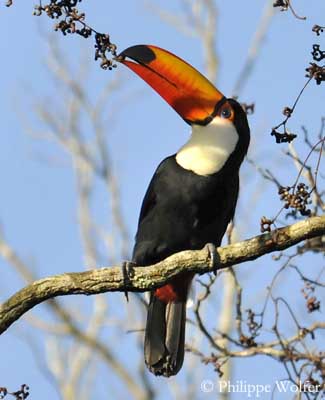
Toco Toucan is very agile, and is able to hang and turn easily upside-down to pluck fruits with the long bill. It can twist them off and detach them by tugging with force.
The large bill is sometimes used as a weapon during interactions, in order to establish the hierarchy within the group.
Toco Toucan is a cavity-nester and often returns to the same nest the next season. It cleans it and prepares the cavity for the laying. This species may nest on or inside termite mounds on the ground, often using old abandoned nest by woodpeckers such as Campo Flicker (Colaptes campestris).
The cavity, in addition to be cleaned, becomes deeper and deeper year after year because the toucan tears into the rotted wood in the cavity it uses.
The potential nest-sites are selected within two months before the laying.
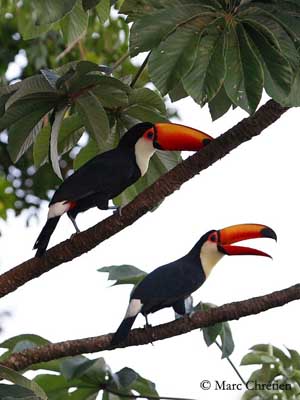
Toucan Toco performs courtship feeding and mutual preening, the latter can occur throughout the year.
Both mates often tap their bills. The male may cock the tail, in order to expose the red undertail coverts.
Some interactions occur. The aggressive male gives loud rattling or performs bill-clapping, face-on to opponent, approach and attack.
They can breed at 3-4 years, rarely sooner.
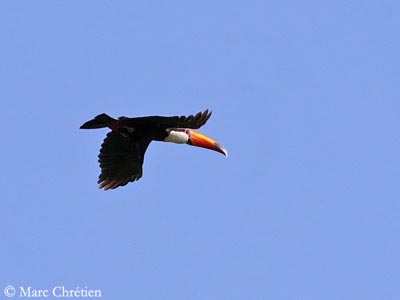
FLIGHT:
Toco Toucan has undulating flight with series of wing-beats alternating with glides.
To cross wide rivers is something difficult for this large bird. It gradually looses height and might fall into the water before to land.
Toucans do not perform aerial displays as other members of the order Piciformes.
They move by bounds, hops and jumps into the tree branches, and they are able to cling to the smallest.


REPRODUCTION:
Breeding season varies according to the range.
This species nests in cavities, sometimes in hollow palms, in banks of rivers or in termite mounds on the ground. When in tree, the nest entrance is between 2 and 30 metres above the ground. The entrance is narrow, and the interior is lined with fruit stones, up to 7 cm in depth.
Female lays 2-4 eggs. Incubation lasts 17-18 days, shared by both parents. The chicks are fed with insects during the first days, and then, more and more fruits are added. Female feeds them more than male, as they are growing up.
The nest is kept clean during the first days, but it becomes quickly dirty later. The young fledge between 43 and 52 days after hatching.
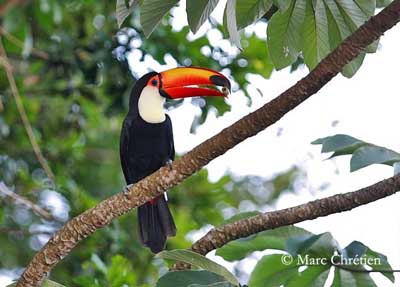
Toco Toucans reared in captivity can raise several broods per year. The male is often aggressive to its mate at times. Young are fed with insects, mice and dog food. Captive birds may live at least 15 years.
DIET:
Toco Toucan feeds mainly on fruits such as figs from Cacos, Capsicum, Psidium and Sterculia, oranges and other fruit’s species. But it also consumes insects such as caterpillars and termites. It also steals eggs and nestlings of other birds’ species, and lizards. They usually forage in small groups.
Toco Toucan consumes most part of fruit at fruiting trees, and plays an important role in seed dispersal in forest.
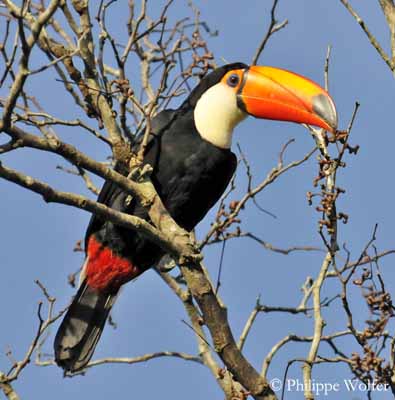
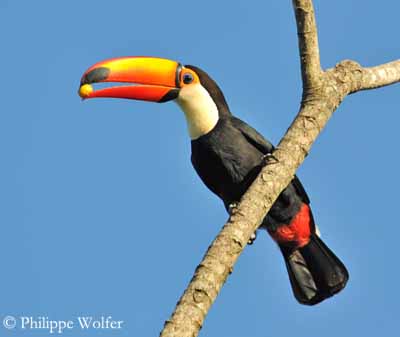
PROTECTION / THREATS / STATUS:
Toco Toucan benefits from deforestation in South America, because this species prefers open areas. It is fairly common and the species is not threatened at this moment, classified as Least Concern. However, hunting and trapping for pets and zoos need to be monitored.
